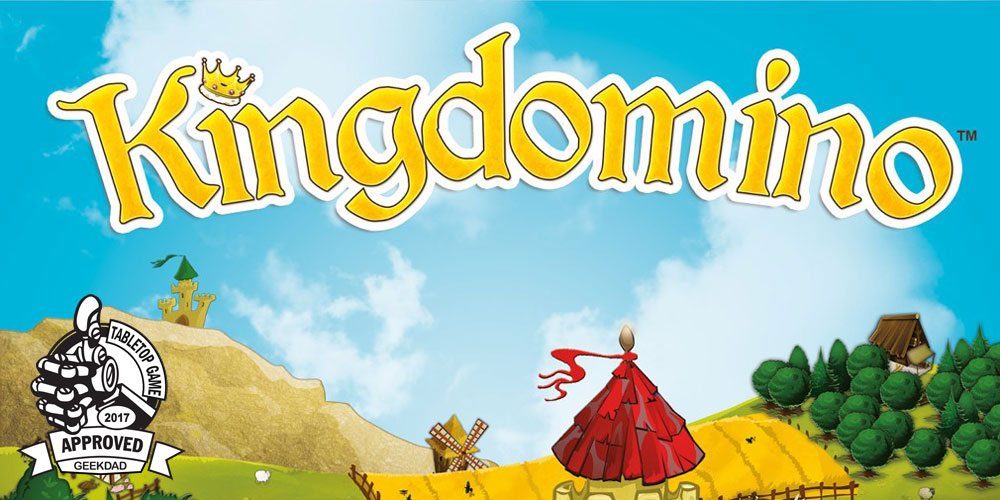Claim the best lands for your kingdom, adding fields, forests, lakes, and mountains to your domain. Kingdomino is like a quick-playing mixture of Carcassonne and dominoes.
At a glance: Kingdomino is a game by Bruno Cathala for 2 to 4 players, ages 8 and up, and takes about 15 minutes to play. It retails for $19.99 and is available now online or at your local game store. The game is pretty easy to learn even for kids, but engaging enough for adult players, too. I’ve even played it with my youngest daughter (nearly 4), though she plays it more like a puzzle rather than really understanding the scoring, which requires some simple multiplication.
Kingdomino is GeekDad Approved!

Components
- 4 starting tiles (square)
- 4 castles
- 8 meeples (2 per color)
- 48 domino tiles
All of the tiles are sturdy cardboard and are pre-punched. The thickness of the tiles and the sharp corners do make them a little tricky to shuffle well, but they look and feel pretty nice. One thing I really love is all the tiny details in the illustrations, which were done by Cyril Bouquet. You’ll notice fun details that differentiate various tiles of the same type and add a bit of flavor to what is mostly an abstract game.

The castles need to be punched out and assembled. It’s a cute feature that isn’t really necessary, because it just sits on your starting tile and makes it stand out a little more. My kids, of course, love the castles and like to put the extra meeple inside it.
The meeples are fun—the rulebook calls them king meeples, but since they’re silhouettes of a figure wearing a crown and robe, I figure they work just as well as queens, if that’s your preference.
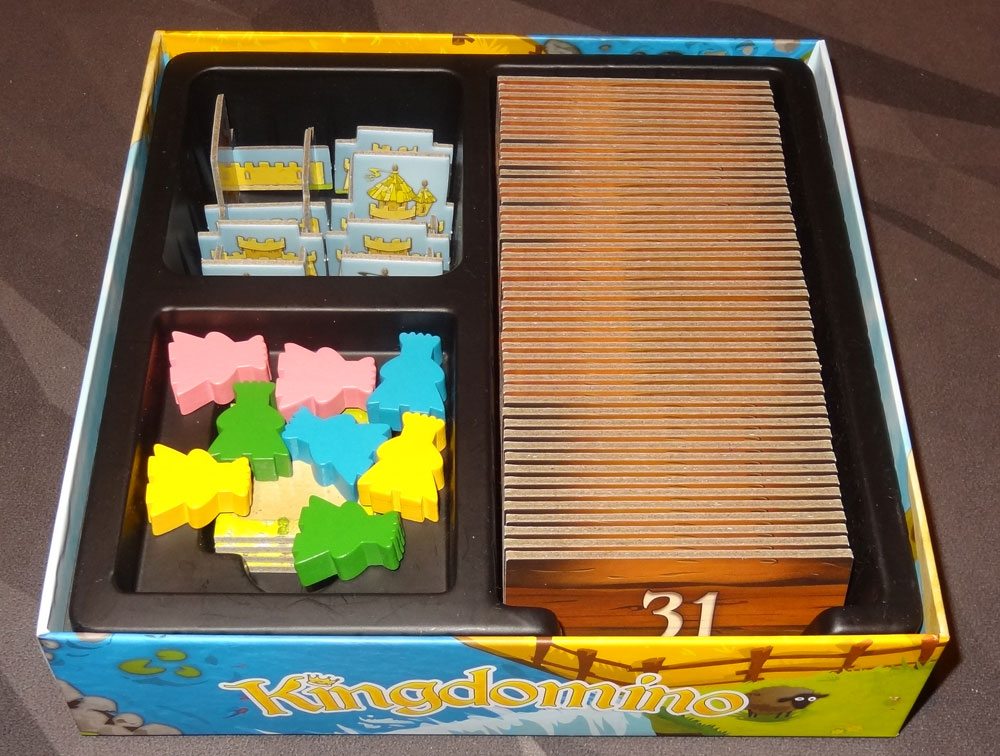
The box insert has room for the assembled castles, the meeples, and all of the domino tiles—but it’s also really handy as a way to hold all the dominoes during play.
The back of the rulebook has a handy chart showing how many squares of each terrain type there are, so you can gauge the probabilities of getting another windmill for your fields, or how many crowns there are in the mines.
How to Play
The object of the game is to build your 5×5 kingdom to score the most points, creating valuable territories.
To set up, give everyone a starting tile, the matching castle, and meeples. (Players get 2 meeples in a 2-player game, or 1 meeple otherwise.) Shuffle the dominoes and then place them back in the box as a draw pile. The number of dominoes used is based on the number of players (12 per player), though I’ve usually been able to tell when we’ve hit the right number of tiles rather than counting out a number to set aside.
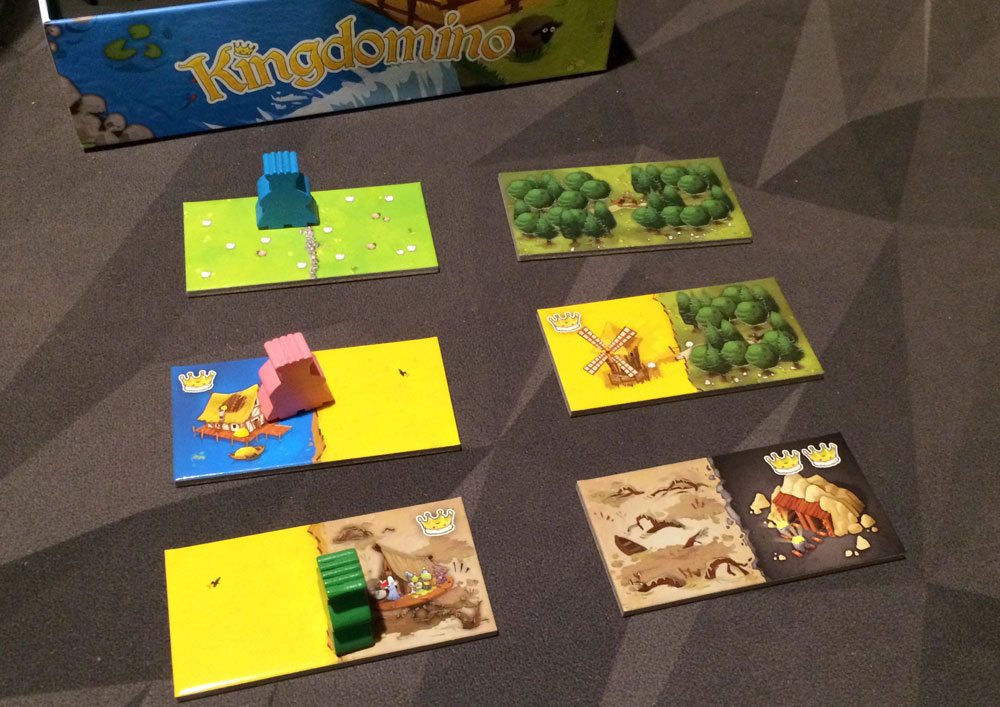
You start by laying out the first set of dominoes—one per meeple—in numerical order, and then flip them over to reveal the terrain types. For the first round, randomize the turn order by shaking up the meeples and dropping them out one at a time. When your meeple drops, take it and place it on one of the dominoes that has not yet been claimed. Then, once all meeples have been placed, draw another set of dominoes, put them in order, and reveal them. The game is ready to begin.
Each round, you start with the player whose meeple is on the lowest-numbered domino, and move down the row. The player takes the domino, plays it into their kingdom, and then places their meeple on an available domino in the next row. When you finish the row, you draw another set of dominoes and repeat the process, until the game ends.
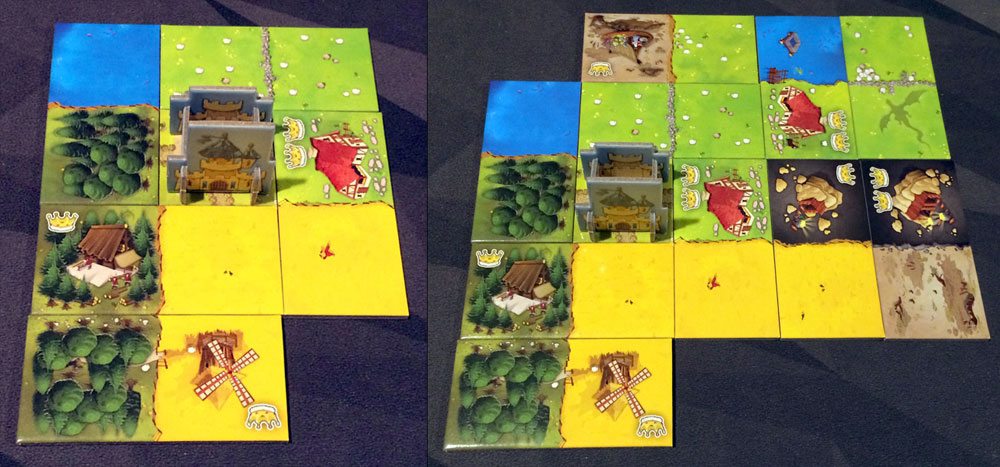
When you place a domino into your kingdom, it must be placed so that at least one end matches something that it’s touching. Your starting tile is wild, so anything can match it. Also, your entire kingdom must fit within a 5×5 grid, so no tile may be placed so that any parts are outside that boundary. (Your castle does not have to be at the center of the grid.) If you ever take a tile but are unable to play it, it gets discarded and you’ll just have fewer tiles in your kingdom at the end of the game.
Once the set number of tiles has been claimed (enough for every player to fill the 5×5 grid exactly if they didn’t have to discard anything), the game ends, and you score points.
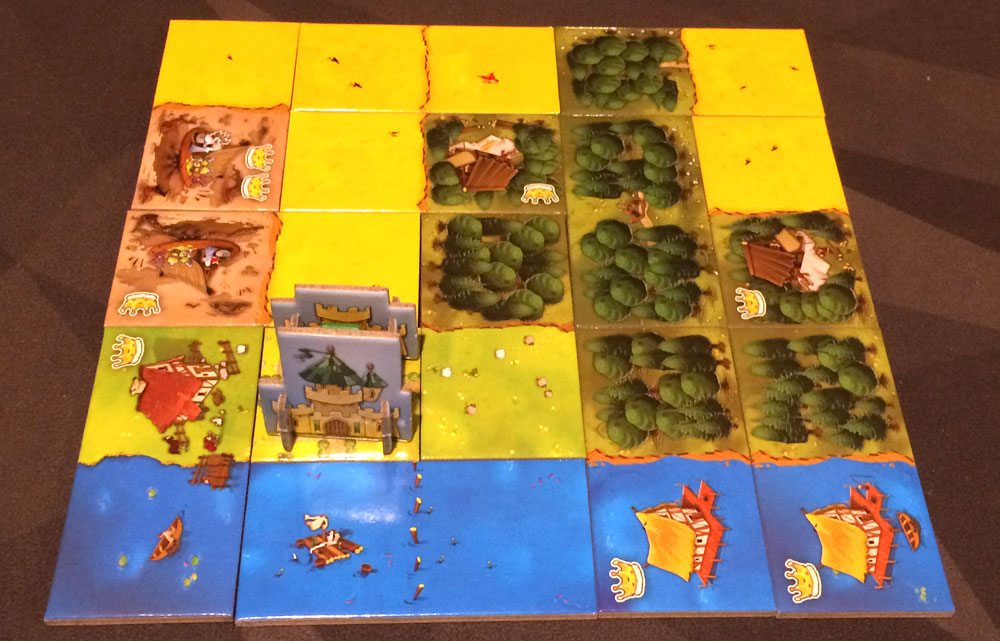
For each contiguous section of a terrain type (known as a “property”), you count how many squares it is, multiplied by the number of crowns in it, to determine the score. A property that has no crowns in it is worth no points, no matter how large it is. For instance, in the photo above, the lake at the bottom is worth 10 points, since it is 5 squares wide and has 2 crowns in it. The two sections of yellow fields are worth no points, because neither has any crowns.
Add up the value of all your properties to get your score—highest score wins. Ties go to the player with the largest property (even if it has no crowns), and then to the player with the most total crowns.
There are some variant rules as well, in case you want to throw in some bonus points or mix it up a bit:
- Dynasty: Play 3 rounds and total your score.
- The Middle Kingdom: Score 10 bonus points if your castle is in the center of your kingdom.
- Harmony: Score 5 bonus points if your territory is complete and has no gaps or holes.
- Mighty Duel: With 2 players, you can use all of the dominoes to build 7×7 grids.
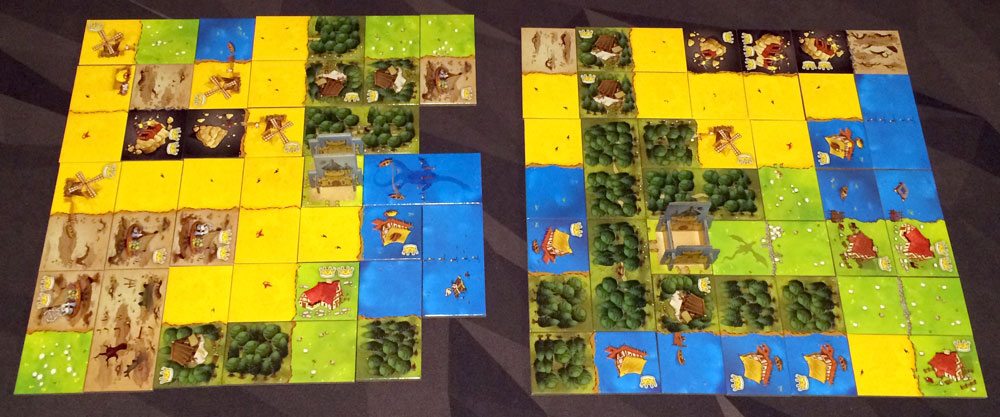
The Verdict
Okay, before I get into how much I love this game, I have to pause and ask: how do you pronounce Kingdomino? I mean, it’s a clever portmanteau, combining “kingdom” and “domino.” But when you say it out loud, you realize that the “dom” isn’t pronounced the same way in both words, particularly because of where the accent falls. Is it KINGdomino or kingDOMino? My preference is the latter, but then it sounds like “King Domino” and you lose the “kingdom” pun. Ah, well. Maybe nobody but me cares.
And, really, you probably won’t care so much how it’s pronounced—you’ll be too busy playing it.
Kingdomino is a fairly light game, and it really does play in about 15–20 minutes unless you have players who take forever making decisions—and even then it’s not that long. The rules are easy enough that my 3-year-old knows how to play it, though she’s not great at multiplication so she’s more interested in picking dominoes that have fun features on them than actually scoring points. However, just because it’s easy enough for kids doesn’t mean that it’s only for kids. I’ve played it with just my kids, with my kids and adults, and with just adults, and I’ve had a lot of fun each time.
My 10-year-old in particular has really fallen in love with it, and when I’m not available, she’ll sit and play it with her little sister. We’ve played a number of times, just the two of us, and it works well as a 2-player game. We’ve been particularly fond of the Mighty Duel variant.

I have a soft spot for tile-laying games. One of the games that first got me into gaming is Carcassonne, in which you lay out tiles and try to complete various features to score points. It has a fairly simple rule set that can lead to fairly deep gameplay, and it’s a game that I still play to this day (mostly online now), which isn’t something that can be said for many of the games I played a decade ago. I love the puzzle aspect, finding the best place to put a tile, and I also love seeing the “map” that I’ve built at the end of the game.
Kingdomino scratches that same itch: you still have that puzzle aspect, where you have to figure out how to place a tile so that it maximizes your score and leaves possibilities for what might come next. Unlike Carcassonne, there’s also a little bit of a packing problem (like Tetris) because everything has to fit in that limited grid. If you don’t plan ahead, you often end up with some gaps in the corners or on an edge that will never be filled. Or, sometimes you gamble that the points you’ll get for placing a particular domino will outweigh the domino that you have to discard because there’s no room.
In addition, Kingdomino also has a bit of a bidding component. The tiles are always arranged in numerical order—generally, the rarer terrain types (and crowns) appear on higher numbers. Whenever you choose a tile, you are also choosing your turn order for the next round. Do you take that valuable mine with 2 crowns, knowing that you’ll get last choice in the next round? Or do you settle for the 2-field domino, hoping that the tile you really want will turn up next? It’s a fun risk-reward choice that works really well. Of course, there’s also the option of taking the tile that doesn’t really help you much but is very valuable to your opponents, simply to prevent them from getting it.
The scoring system allows for some great strategies, as you choose dominoes and consider where to place them. It’s pretty common to have a domino that will open up connections for one property but close off another, and it’s always a gamble to decide which way to go. You can score a lot of points if you take a lot of the lower-numbered fields and forests but manage to get several crowns—or by fighting over the high-numbered (but rare) mines.
Although the game would work perfectly well with just plain colored dominoes marked with crowns, the artwork on them is really delightful. While you’re waiting for your turn (and it won’t be a long wait, usually), you can survey your dominion and admire all the little details—the sheep that’s terrified by the dragon flying overhead, a wizard mixing up concoctions in the swamp, the fisherman repairing the thatched roof of his hut. I like that very few tiles are exactly identical.
Overall, Kingdomino has been a hit for my family and my gaming group, and it was a no-brainer to award it the GeekDad stamp of approval. It’s an excellent price for a game that I’m sure I’ll keep coming back to, and I love that it works for a broad range of experience levels and ages. I’ve only had it for about 3 weeks and it’s already in my top three most-played games of this year. If you enjoy tile-laying games, it’s definitely worth a try.
Disclosure: I received a review copy of this game.
